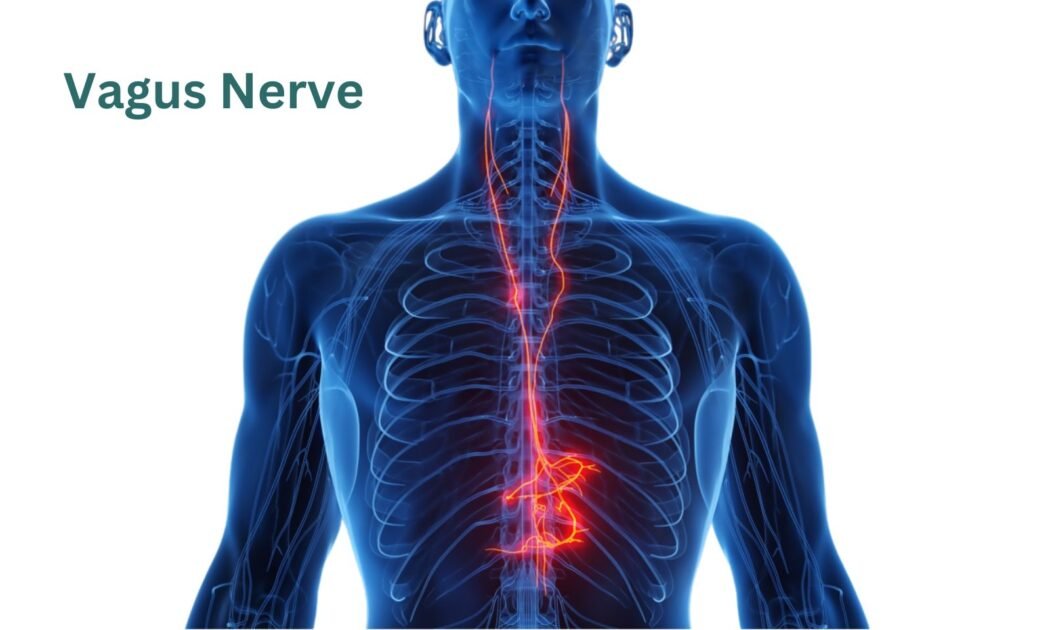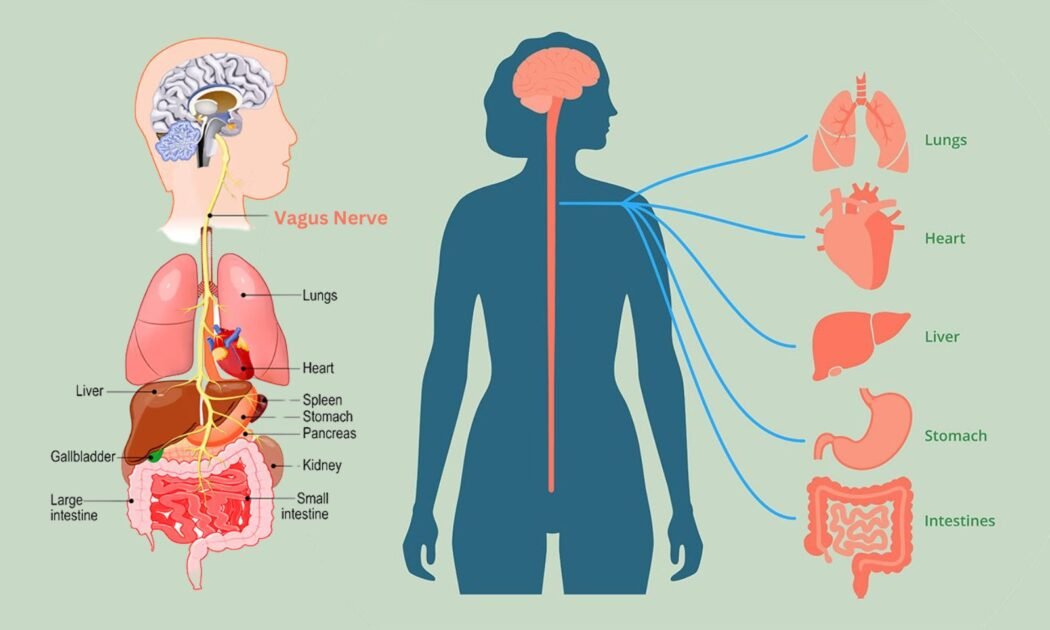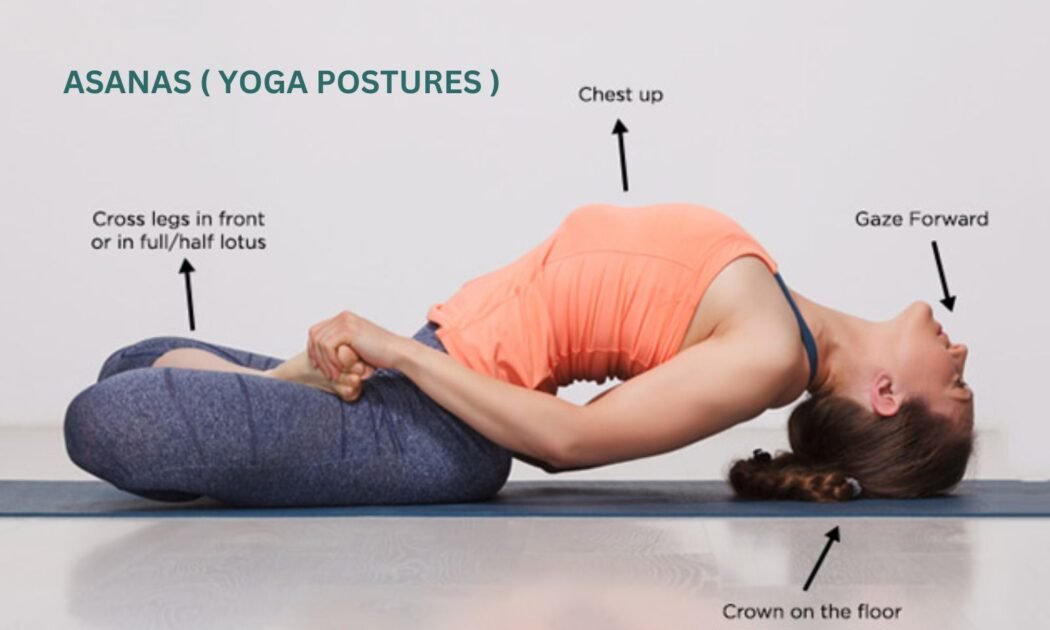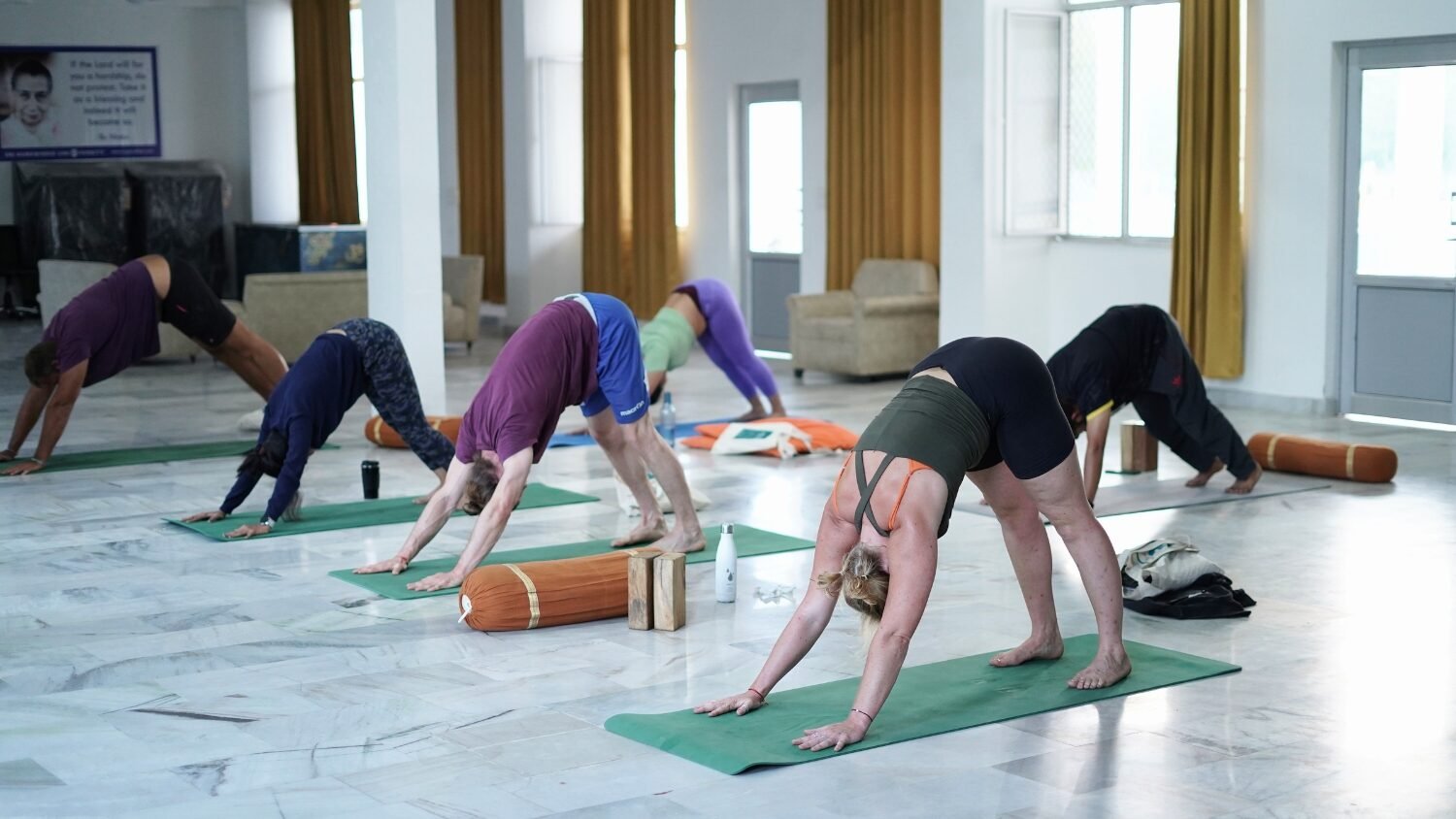
Vagus Nerve Health and Yoga – Key to a Balanced Body and Mind
In the intricate web of the human nervous system, the vagus nerve stands out as a master communicator. It plays a pivotal role in regulating critical functions such as heart rate, digestion, mood, and immune responses. Known as the “wandering nerve” because of its far-reaching influence, the vagus nerve is the primary component of the parasympathetic nervous system—the system responsible for our ability to relax and recover.
In the intricate web of the human nervous system, the vagus nerve stands out as a master communicator. It plays a pivotal role in regulating critical functions such as heart rate, digestion, mood, and immune responses. Known as the “wandering nerve” because of its far-reaching influence, the vagus nerve is the primary component of the parasympathetic nervous system—the system responsible for our ability to relax and recover.
In the intricate web of the human nervous system, the vagus nerve stands out as a master communicator. It plays a pivotal role in regulating critical functions such as heart rate, digestion, mood, and immune responses. Known as the “wandering nerve” because of its far-reaching influence, the vagus nerve is the primary component of the parasympathetic nervous system—the system responsible for our ability to relax and recover.

Understanding the Vagus Nerve: The Body’s Information Superhighway
What is the Vagus Nerve?
The vagus nerve is the tenth cranial nerve (CN X) and the longest of the cranial nerves, extending from the brainstem down through the neck, chest, and abdomen. It innervates several major organs, including the heart, lungs, liver, stomach, and intestines. The name “vagus” comes from the Latin word for “wandering,” reflecting its widespread reach throughout the body.
Functions of the Vagus Nerve
The vagus nerve has far-reaching functions that include:
- Regulating heart rate and blood pressure
- Supporting digestion by innervating the gastrointestinal tract
- Controlling immune responses and inflammation
- Facilitating the relaxation response (parasympathetic activation)
- Affecting mood, stress, and emotional regulation
Vagal Tone: The Measure of Vagus Nerve Health
The vagal tone refers to the activity of the vagus nerve. A higher vagal tone is associated with better physical and mental health, including:
- Lower heart rate and blood pressure
- Reduced stress and anxiety
- Improved emotional resilience
- Better digestion
- Stronger immune function
Conversely, poor vagal tone can contribute to issues such as:
- Chronic stress
- Depression and anxiety disorders
- Inflammatory conditions
- Poor digestion and irritable bowel syndrome (IBS)
- Heart disease

The Vagus Nerve and the Autonomic Nervous System (ANS)
The vagus nerve is the main component of the parasympathetic nervous system (PNS), often referred to as the “rest and digest” system. It acts as a counterbalance to the sympathetic nervous system (SNS), or the “fight or flight” system.
In modern life, many of us experience chronic stress, which means the SNS is over-activated and the PNS is under-activated. This imbalance can lead to nervous system dysregulation, resulting in stress-related disorders, anxiety, fatigue, and immune dysfunction.
Vagus nerve stimulation helps to shift the body back into a parasympathetic dominant state, encouraging relaxation, recovery, and healing. This is where yoga becomes an incredibly effective tool.
Yoga and the Vagus Nerve: The Science Behind the Connection
Yoga, an ancient practice that combines movement, breath control, and meditation, has been shown to stimulate the vagus nerve and improve vagal tone. The practice encourages parasympathetic activation, promoting calmness, balance, and resilience.
Scientific Studies on Yoga and Vagal Tone
1. Heart Rate Variability (HRV) and Yoga:
Heart Rate Variability (HRV) is a biomarker for vagal tone. A higher HRV indicates a healthy vagus nerve and strong parasympathetic activity. Studies have shown that regular yoga practice can increase HRV, reflecting enhanced vagal function.
2. Yoga, Stress Reduction, and Inflammation:
Chronic stress leads to inflammation, which impairs vagal function. Yoga reduces stress hormones like cortisol and lowers systemic inflammation, improving vagus nerve health.
3. Breath Control (Pranayama) and the Vagus Nerve:
Controlled breathing techniques used in yoga, such as slow diaphragmatic breathing, directly stimulate the vagus nerve through the mechanical movement of the diaphragm and modulation of heart rate and blood pressure.
Yoga Practices to Stimulate the Vagus Nerve
1. Breathwork (Pranayama)

Breathing exercises are among the most direct ways to stimulate the vagus nerve. The diaphragm’s movement during deep breathing massages the vagus nerve, signaling the brain to enter a parasympathetic state.
Effective Pranayama Techniques:
• Nadi Shodhana (Alternate Nostril Breathing)
Balances the left and right hemispheres of the brain, calms the mind, and enhances vagal tone.
• Ujjayi Breathing (Victorious Breath)
Creates a gentle sound at the back of the throat, increasing focus, calming the nervous system, and stimulating the vagus nerve.
• Bhramari (Bee Breath)
Humming during exhalation increases vagal stimulation through vibration, which can lead to an immediate calming effect.
How to Practice Deep Belly Breathing:
• Sit or lie down comfortably.
• Place one hand on the belly and one on the chest.
• Inhale deeply through the nose, allowing the belly to expand.
• Exhale slowly, feeling the belly contract.
• Repeat for 5–10 minutes daily.
2. Asanas (Yoga Postures)

Certain yoga postures stimulate the vagus nerve by improving circulation, spinal alignment, and parasympathetic activation.
Poses to Support Vagal Tone:
• Supta Baddha Konasana (Reclined Bound Angle Pose)
Opens the chest and relaxes the abdomen, promoting diaphragmatic breathing.
• Viparita Karani (Legs-Up-the-Wall Pose)
Promotes venous return and relaxation; calms the nervous system and reduces stress.
• Balasana (Child’s Pose)
Provides a sense of security, reduces heart rate, and stimulates the parasympathetic nervous system.
• Setu Bandhasana (Bridge Pose)
Opens the chest and supports the parasympathetic nervous system.
• Matsyasana (Fish Pose)
Stimulates the throat and chest region, areas innervated by the vagus nerve.
3. Meditation and Mindfulness

Meditation reduces sympathetic nervous system over-activity and increases parasympathetic dominance by stimulating the vagus nerve. Regular meditation has been shown to increase gray matter in regions of the brain associated with emotion regulation and vagal tone.
Types of Meditation for Vagus Nerve Stimulation:
• Loving-Kindness Meditation (Metta)
Promotes positive emotions and social connection, boosting vagal tone.
• Body Scan Meditation
Enhances interoception (awareness of internal bodily sensations), which is linked to increased vagal activation.
• Mindful Breathing
Brings awareness to the breath, promoting relaxation and vagal stimulation.
4. Chanting and Sound Therapy

The vagus nerve innervates the vocal cords and muscles at the back of the throat. Chanting, singing, and humming stimulate these areas and send signals to the brain to relax.
Practices:
• OM Chanting
The sound vibration resonates through the body, directly stimulating the vagus nerve.
• Mantra Repetition
Repeating calming phrases or sounds fosters relaxation and enhances vagal tone.
Lifestyle Habits to Support Vagus Nerve Health
In addition to yoga, adopting simple lifestyle changes can support vagus nerve health and parasympathetic activity.
1. Cold Exposure
Brief exposure to cold (cold showers, splashing cold water on the face) can activate the vagus nerve by stimulating the parasympathetic response.
2. Social Connection
Positive social interactions, eye contact, and genuine connection stimulate vagal tone through the release of oxytocin, the “bonding hormone.”
3. Laughter and Joy
Laughter increases HRV and stimulates the vagus nerve. Prioritize joy and playful activities to support relaxation.
4. Nutrition for Vagus Nerve Health
A gut-healthy diet rich in probiotics, fiber, and anti-inflammatory foods supports the gut-brain axis and the vagus nerve.
5. Massage and Bodywork
Neck and shoulder massages, craniosacral therapy, and abdominal massages stimulate areas innervated by the vagus nerve, encouraging parasympathetic activity.
Yoga Sequence for Vagus Nerve Health (30–45 minutes)
Opening Breathwork (5 minutes)
• Seated Deep Belly Breathing
• Nadi Shodhana (Alternate Nostril Breathing)
Gentle Warm-Up (5 minutes)
• Cat-Cow Pose (Marjaryasana/Bitilasana)
• Neck Stretches
Asana Practice (20–25 minutes)
1. Supta Baddha Konasana (Reclined Bound Angle Pose) – 3-5 minutes
2. Viparita Karani (Legs-Up-the-Wall Pose) – 5 minutes
3. Balasana (Child’s Pose) – 2 minutes
4. Setu Bandhasana (Bridge Pose) – 5 breaths x 3 rounds
5. Matsyasana (Fish Pose) – 3-5 breaths
6. Savasana (Corpse Pose) – 5-10 minutes with mindful breathing
Closing Meditation and Chanting (5–10 minutes)
• OM Chanting
• Loving-Kindness Meditation
Real-Life Stories: Yoga and Vagal Healing
Sarah’s Story
After years of battling anxiety and digestive issues, Sarah turned to yoga. Incorporating breathwork, gentle postures, and meditation, she noticed profound changes. “I finally felt like my body was listening to me. I wasn’t stuck in overdrive anymore.”
Raj’s Journey
Raj suffered from chronic stress as a corporate executive. Discovering pranayama and OM chanting, he found relief. “The simple act of breathing and chanting made me feel alive. My heart rate stabilized, and I found peace I didn’t think was possible.”
The Future of Vagus Nerve Stimulation and Yoga
While medical vagus nerve stimulators exist, yoga offers a natural, non-invasive, and accessible method for enhancing vagus nerve health. The growing field of neuroplasticity and mind-body medicine continues to validate what yogis have known for centuries: healing begins within, through the breath, movement, and mindful awareness.
Conclusion: Final Thoughts
The vagus nerve is central to how we experience life—whether we’re thriving in a state of balance or stuck in chronic stress. Yoga provides a time-tested, scientifically backed approach to stimulate, strengthen, and heal this vital nerve.
By incorporating breathwork, asana, meditation, and lifestyle practices, you can unlock the potential of your parasympathetic nervous system, cultivating calm, resilience, and vitality.
Your journey to vagal health can begin right now, with a single conscious breath.
Ready to start? Roll out your mat, take a deep belly breath, and reconnect with your body and mind.












Leave a comment: